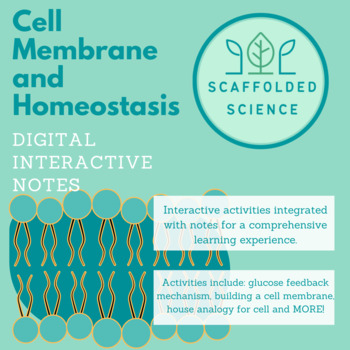Cells: Cell Membrane and Homeostasis
- Google Drive™ folder

What educators are saying
Also included in
- Everything you need for your cells unit! Plus bonus Claim, Evidence, Reasoning writing assignments for FREE! These are wonderful assessments or learning opportunities that promote critical thinking!Please see the individual links for everything included with video previews! These are also listed inPrice $17.55Original Price $19.50Save $1.95
Description
Answer key included!
This lesson works great following my Cells Basics Lesson and the fun Cells Monster Breakout Room Game.
I do include some information on feedback mechanisms without going into extreme detail, This is mostly focused on the general ways that cells maintain homeostasis.
Included is a editable teacher version and a ready to go student version. As with most of my lessons, this is in a Digital Interactive Notebook format for students, with each slide representing one "page" of a digital notebook.
Make sure to scroll to the bottom of my blog video preview.
Here is the breakdown of the lesson:
Title Slide
Slide 1-3: House Analogy- The cell is compared to a house to help students understand the need for controlling what enters and exits the cell. Students answer questions about the analogy to help them understand the comparison.
Slide 4-7: The cell membrane and homeostasis- Homeostasis is defined. Students are given different scenarios based on body temperature, and must answer questions based on their prior knowledge of how the body maintains homeostasis.
Slide 8: Help the cell membrane maintain homeostasis- Students drag the nutrients into the cell and the waste out of the cell in order to help it maintain homeostasis. This helps students understand what needs to enter the cell and what needs to exit.
Slide 9: Hydrophobic vs. Hydrophilic- The concepts of phospholipids making up the membrane and introduced along with the parts of the phospholipid that is hydrophobic and hydrophilic. Students then digitally color the phospholipid, color-coding the label with the correct part o the lipid.
Slide 10-12: Cell Membrane Structure- Students are introduced to the phospholipid bilayer and how it forms. They are also introduced to the fluid mosaic model.
Slide 13: Selectively Permeable- Students are introduced to the idea that the cell membrane is selectively permeable and the types of molecules that can easily pass through the membrane.
Slide 14: Build a membrane- Using the knowledge gained in the previous slides, students drag the components of the cell membrane onto the slide and build a cell membrane. They then drag the labels onto the slide and place them in the correct position.
Slide 15-17: Examples of homeostasis- Students are given examples of the cell regulating homeostasis. The first example includes too much glucose in the blood stream, the second is not enough glucose in the blood stream and the third is too much CO2 in the blood stream. Students must drag the molecules to the correct locations on the slide in order to maintain homeostasis.
Slide 18: When homeostasis is not maintained- Students are told the conditions that occur if homeostasis is not maintained in the body. Students then research further on each condition to understand it fully.



